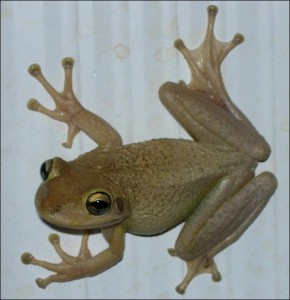Cuban Treefrog (Osteopilus septentrionalis):
The Cuban Treefrog: was introduced into Florida as a stowaway on vehicles and plants in the 1920’s. As of 2013, breeding populations have been recorded as far north as Georgia. Cuban Treefrogs have larger toepads and eyes than any of the native species. Being larger in size, the Cuban Treefrog out-competes other treefrogs for resources, to the point that they are predators of Florida’s treefrogs and inhibitors of native tadpoles.
Juvenile Cuban Treefrogs can be distinguished from natives by their red eyes and hind legs with blue bones. Three-foot-long sections of 1.5 inch diameter PVC pipe can be placed in the landscape to monitor for treefrog species. Should Cubans be found, they should be reported and euthanized. For additional details visit: http://edis.ifas.ufl.edu/uw259.
Would you like to be a Citizen Scientist? You can help Dr. Steve Johnson at the University of Florida Department of Wildlife Ecology and Conservation by reporting suspected Cuban Treefrog sightings. For more information on how you can become a Citizen Scientist, visit The Cuban Treefrog Citizen Scientist Project.
For more information contact the author Sheila Dunning, UF/IFAS Extension Okaloosa County Commercial Horticulture Agent 850-689-5850.
Hydrilla (Hydrilla verticillata):
Hydrilla is a perennial submerged plant that grows in dense mats up to the surface of freshwater habitats, including ponds, lakes, springs, and rivers. Growing at the rapid rate of an inch a day and up to 25 feet long, hydrilla shades out beneficial native plants and clogs waterways, preventing flood control, boating, and fishing. In dense populations, the plant can alter oxygen levels and water chemistry and survive in a wide variety of nutrient conditions, sunlight availability, and temperatures.
Originating in Asia, it was introduced to Florida (likely through Tampa and Miami) in the 1950’s as part of the worldwide aquarium trade. Hydrilla has become a very expensive problem for the state. Millions are spent annually on chemical and mechanical treatment simply to maintain the plant. Adding to the problem is the fact that it is still available commercially, even though it has been placed on the US Federal Noxious Weed List. In the United States, the plant is found as far north as Connecticut and west to California and Washington.
Methods of control include mechanical harvesters and chopping machines (although fragments of hydrilla left in the water can regrow), introduced insects and fish (particularly the Chinese grass carp), aquatic herbicides, and lake drawdowns. Hydrilla is often transported from one body of water to the other by unknowing boaters moving fragments of the plant left on boats, trailers, or live wells, so learning to identify the plant and cleaning boats before leaving the ramp are helpful in prevention. Visit the Extension Hydrilla IPM site for more helpful tips.
For more information contact the author Carrie Stevenson, UF/IFAS Extension Escambia County Coastal Sustainability Agent at 850-475-5230.
- Hurricane Season 2025 - July 7, 2025
- The Striped Burrfish - April 11, 2025
- The Value of Biodiversity - March 28, 2025

![NISAW-logo09[1]](https://nwdistrict.ifas.ufl.edu/nat/files/2014/02/NISAW-logo091-300x119.jpg)

